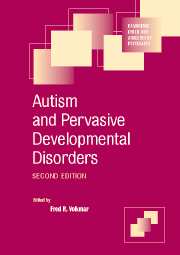Book contents
- Frontmatter
- Contents
- List of contributors
- Preface to the second edition
- 1 Diagnosis and definition of autism and other pervasive developmental disorders
- 2 Epidemiological surveys of pervasive developmental disorders
- 3 Psychological factors in autism
- 4 Communication and its development in autism spectrum disorders
- 5 Genetic epidemiology of autism spectrum disorders
- 6 The neurobiology of autism
- 7 Psychopharmacology
- 8 Behavioral and educational approaches to the pervasive developmental disorders
- 9 The outcome in adult life for people with ASD
- 10 Autism, social neuroscience, and endophenotypes
- Index
Preface to the second edition
Published online by Cambridge University Press: 19 August 2009
- Frontmatter
- Contents
- List of contributors
- Preface to the second edition
- 1 Diagnosis and definition of autism and other pervasive developmental disorders
- 2 Epidemiological surveys of pervasive developmental disorders
- 3 Psychological factors in autism
- 4 Communication and its development in autism spectrum disorders
- 5 Genetic epidemiology of autism spectrum disorders
- 6 The neurobiology of autism
- 7 Psychopharmacology
- 8 Behavioral and educational approaches to the pervasive developmental disorders
- 9 The outcome in adult life for people with ASD
- 10 Autism, social neuroscience, and endophenotypes
- Index
Summary
Interest in what is now recognized as the pervasive developmental disorders can be traced to the middle of the nineteenth century with the first descriptions of childhood “psychosis” (Volkmar, 1996). This interest stemmed from an increasing awareness of the importance of the factors of both experience and endowment in child development. Early descriptions of childhood “insanity” were followed by descriptions of childhood schizophrenia (DeSanctis, 1906). The latter term became synonymous with all forms of severe mental disorder in children. The particular genius of Leo Kanner was reflected in his description in 1943 of the syndrome of infantile autism, which he initially believed to be quite different from the forms of childhood “psychosis” then recognized. In the subsequent six decades autism has been the focus of considerable interest from clinicians and researchers alike so that, for example, a large body of work both on research and intervention is now available (Volkmar et al., 2005).
Autism has been the focus of a very substantial body of work. While major advances have been made in both treatment (NRC, 2001) and research (Volkmar et al., 2005) precise pathophysiological models have yet to be specified. In an attempt to specify such models essentially all the theories of psychology and neurobiology have been utilized. While specification of such mechanisms remains an important, if as yet unrealized, goal considerable accomplishments have been made.
- Type
- Chapter
- Information
- Autism and Pervasive Developmental Disorders , pp. ix - xiiPublisher: Cambridge University PressPrint publication year: 2007

